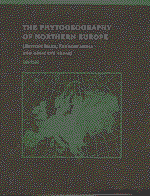Book contents
- Frontmatter
- Contents
- Preface
- Acknowledgements
- 1 Introduction
- 2 Climate
- 3 Edaphic factors
- 4 The geological history of the present European flora
- 5 The atlantic and oceanic elements
- 6 The thermophilic element
- 7 The boreal element
- 8 The arctic, alpine and montane elements
- 9 Endemic, disjunct and centric distribution patterns
- 10 Anthropochorous plants
- Appendix I Calculation of climatic parameters for comparison with plant distributional data
- Appendix II The Northern European species of Flora Europaea with indications of their status and climatic correlations
- Appendix III Arctic species of vascular plants
- Appendix IV Endemic species of vascular plants, bryophytes and lichens
- Appendix V Extra-European disjunctions – bryophytes and lichens
- References
- Index
Appendix II - The Northern European species of Flora Europaea with indications of their status and climatic correlations
Published online by Cambridge University Press: 23 October 2009
- Frontmatter
- Contents
- Preface
- Acknowledgements
- 1 Introduction
- 2 Climate
- 3 Edaphic factors
- 4 The geological history of the present European flora
- 5 The atlantic and oceanic elements
- 6 The thermophilic element
- 7 The boreal element
- 8 The arctic, alpine and montane elements
- 9 Endemic, disjunct and centric distribution patterns
- 10 Anthropochorous plants
- Appendix I Calculation of climatic parameters for comparison with plant distributional data
- Appendix II The Northern European species of Flora Europaea with indications of their status and climatic correlations
- Appendix III Arctic species of vascular plants
- Appendix IV Endemic species of vascular plants, bryophytes and lichens
- Appendix V Extra-European disjunctions – bryophytes and lichens
- References
- Index
Summary
BI is British Isles, Fe is Fennoscandia. Information on status in the two areas is based on available evidence – i is indigenous, n is aturalised, e is ephemeral, * is endemic to the area.
Wl is the mean temperature (°C) of the coldest month calculated for the lowest altitudes in the Atlas Florae Europaeae squares - to be compared with the distribution of atlantic species.
R is the R-value calculated for the lowest altitudes in the squares – to be compared with the distribution of thermophilic plants.
Wh is the mean temperature (°C) of the coldest month calculated for the highest point in each square – to be compared with the distribution of boreal species.
Tmax is the mean annual maximum temperature (°C) calculated for the highest point in each square – to be compared with the distribution of montane and alpine species.
The sequence of families and genera is according to Flora Europaeabased on D. M. Moore: Check-list and chromosome index. Flora Europaea, 1982. The nomenclature is mainly according to the same source, but modified according to Clapham
et al (1987) and Lid (1985).
Although all species occurring in Northern Europe according to Flora Europaea are listed in this appendix, correlations between their distribution and the four climatic parameteres are only presented for those species where the correlations are realistic and ecologically plausible.
- Type
- Chapter
- Information
- The Phytogeography of Northern EuropeBritish Isles, Fennoscandia, and Adjacent Areas, pp. 162 - 234Publisher: Cambridge University PressPrint publication year: 1998



